Huawei Technologies R240D Remote Radio Unit User Manual
Huawei Technologies Co.,Ltd Remote Radio Unit Users Manual
Contents
Users Manual

R230D&R240D
Product Description
Issue 02
Date 2015-10-31
HUAWEI TECHNOLOGIES CO., LTD.

Issue 02 (2015-10-31) Huawei Proprietary and Confidential
Copyright © Huawei Technologies Co., Ltd.
i
Copyright © Huawei Technologies Co., Ltd. 2015. All rights reserved.
No part of this document may be reproduced or transmitted in any form or by any means without prior
written consent of Huawei Technologies Co., Ltd.
Trademarks and Permissions
and other Huawei trademarks are trademarks of Huawei Technologies Co., Ltd.
All other trademarks and trade names mentioned in this document are the property of their respective
holders.
Notice
The purchased products, services and features are stipulated by the contract made between Huawei and
the customer. All or part of the products, services and features described in this document may not be
within the purchase scope or the usage scope. Unless otherwise specified in the contract, all statements,
information, and recommendations in this document are provided "AS IS" without warranties, guarantees or
representations of any kind, either express or implied.
The information in this document is subject to change without notice. Every effort has been made in the
preparation of this document to ensure accuracy of the contents, but all statements, information, and
recommendations in this document do not constitute a warranty of any kind, express or implied.
Huawei Technologies Co., Ltd.
Address: Huawei Industrial Base
Bantian, Longgang
Shenzhen 518129
People's Republic of China
Website: http://e.huawei.com
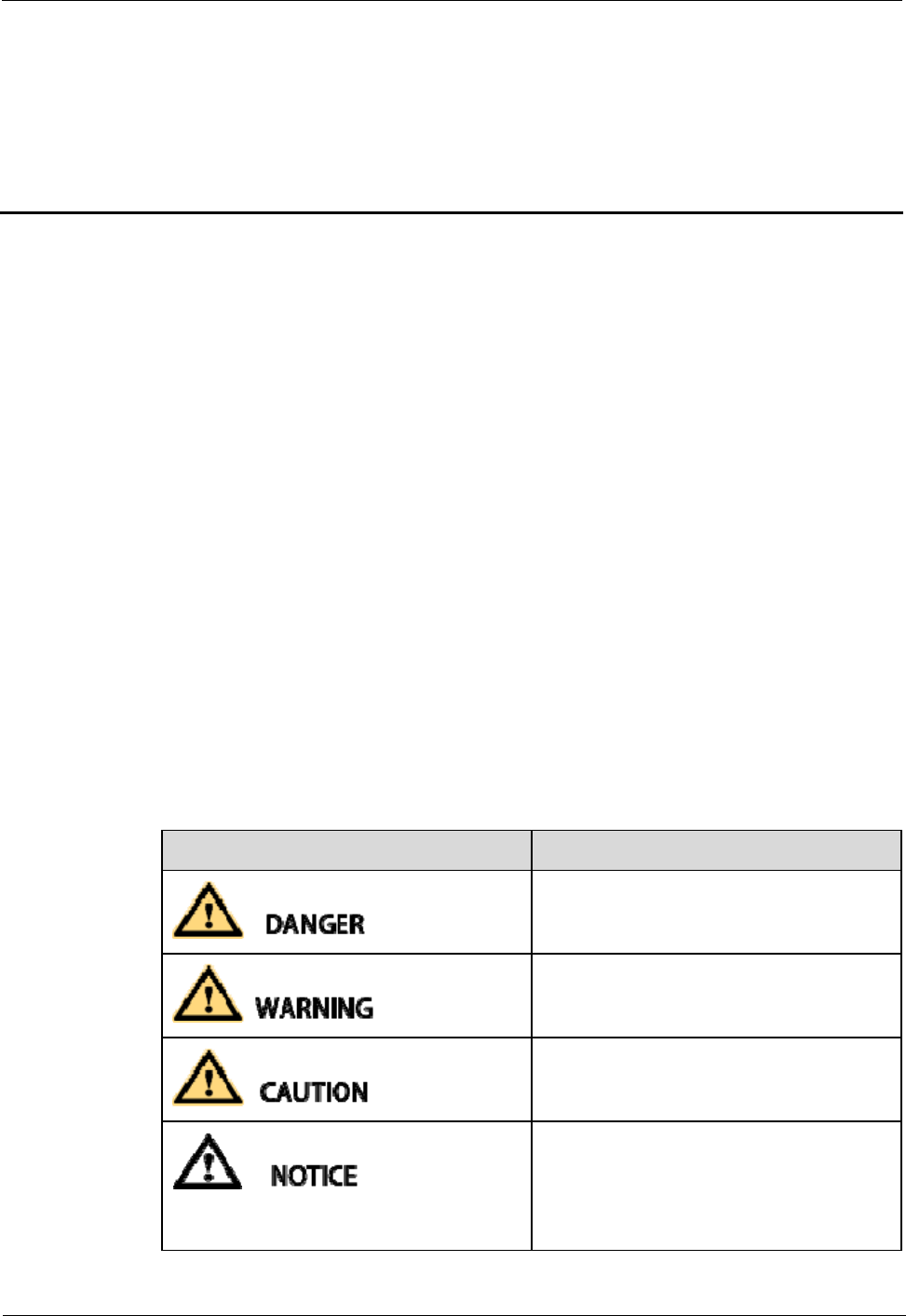
R230D&R240D
Product Description About This Document
Issue 02 (2015-10-31) Huawei Proprietary and Confidential
Copyright © Huawei Technologies Co., Ltd.
ii
About This Document
Intended Audience
This document describes the positioning, characteristics, hardware structure, product features,
and technical specifications of the RRU.
This document helps you understand the characteristics and features of the RRU.
This document is intended for:
Network planning engineers
Hardware installation engineers
Commissioning engineer
Data configuration engineers
On-site maintenance engineers
Network monitoring engineers
System maintenance engineers
Symbol Conventions
The symbols that may be found in this document are defined as follows.
Symbol Description
Indicates an imminently hazardous situation
which, if not avoided, will result in death or
serious injury.
Indicates a potentially hazardous situation
which, if not avoided, could result in death
or serious injury.
Indicates a potentially hazardous situation
which, if not avoided, may result in minor
or moderate injury.
Indicates a potentially hazardous situation
which, if not avoided, could result in
equipment damage, data loss, performance
deterioration, or unanticipated results.
NOTICE is used to address practices not

R230D&R240D
Product Description About This Document
Issue 02 (2015-10-31) Huawei Proprietary and Confidential
Copyright © Huawei Technologies Co., Ltd.
iii
Symbol Description
related to personal injury.
Calls attention to important information,
best practices and tips.
NOTE is used to address information not
related to personal injury, equipment
damage, and environment deterioration.
Change History
Changes between document issues are cumulative. The latest document issue contains all the
changes made in previous issues.
Changes in Issue 02 (2015-10-31)
This version has the following updates:
Added the R230D.
Changes in Issue 01 (2015-08-31)
This is the initial commercial release.

R230D&R240D
Product Description Contents
Issue 02 (2015-10-31) Huawei Proprietary and Confidential
Copyright © Huawei Technologies Co., Ltd.
iv
Contents
About This Document .................................................................................................................... ii
1 Product Positioning and Characteristics ................................................................................... 1
1.1 Product Positioning ....................................................................................................................................................... 1
1.2 Product Characteristics ................................................................................................................................................. 2
2 Hardware Structure....................................................................................................................... 4
2.1 R230D ........................................................................................................................................................................... 4
2.2 R240D ........................................................................................................................................................................... 8
3 Product Features .......................................................................................................................... 12
3.1 WLAN Features .......................................................................................................................................................... 12
3.2 Network Features ........................................................................................................................................................ 13
3.3 QoS Features ............................................................................................................................................................... 13
3.4 Security Features ........................................................................................................................................................ 13
3.5 Maintenance Features ................................................................................................................................................. 14
3.6 BYOD ......................................................................................................................................................................... 14
3.7 Spectrum Analysis ...................................................................................................................................................... 14
4 Technical Specifications ............................................................................................................ 15
4.1 Basic Specifications .................................................................................................................................................... 15
4.2 Radio Specifications (R230D) .................................................................................................................................... 16
4.3 Radio Specifications (R240D) .................................................................................................................................... 20
4.4 Standards Compliance ................................................................................................................................................ 24

R230D&R240D
Product Description 1 Product Positioning and Characteristics
Issue 02 (2015-10-31) Huawei Proprietary and Confidential
Copyright © Huawei Technologies Co., Ltd.
1
1 Product Positioning and Characteristics
1.1 Product Positioning
Product Overview
The R230D and R240D are remote radio units (RRUs) used in Huawei agile distributed Wi-Fi
solution. They support PoE power supply, and are deployed indoors and connected to the
central AP. The central AP and RRUs are connected through network cables, which greatly
extends the coverage range, enhances flexibility in AP deployment and planning, and reduces
the engineering construction costs. The central AP manages the RRUs and processes services
in a centralized manner. The RRUs process radio signals independently. Such distributed
architecture further improves the wireless access capability, creating optimal service
experience for users.
The RRU uses an 86 mm plate in compliance with international standards and can be easily
installed into a junction box in a room. It is equipped with a built-in antenna and a hidden
indicator; therefore, installation of the RRU does not affect indoor decorations and designs. It
also has an IEEE 802.11a/b/g/n/ac wireless module and can work on both 5 GHz and 2.4 GHz
frequency bands.
The RRU is recommended for environments with complex wall structures and high-density
rooms, such as schools, hotels, hospitals, and office meeting rooms. Signals are transmitted
through network cables without attenuation. The RRUs are deployed indoors and provide
comprehensive signal coverage.
The RRUs are managed by the central AP. The central AP and RRUs are plug-and-play and
can be managed and maintained in real time. Compared with traditional distributed AP
solutions, the AC in Huawei agile distributed Wi-Fi solution needs to manage a smaller
number of APs. A large number of RRUs can be deployed, which improves the overall
performance and reduces network deployment costs.
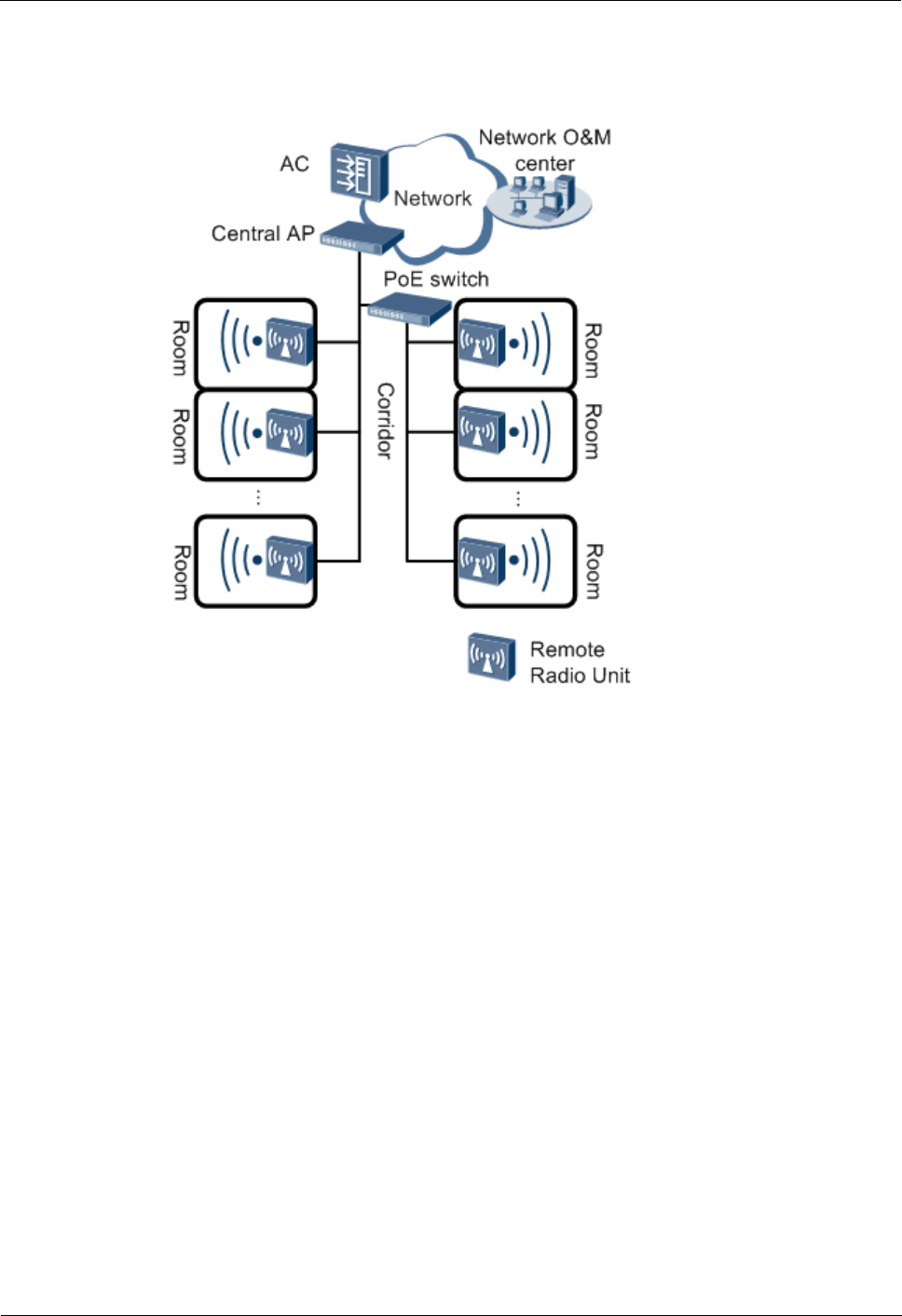
R230D&R240D
Product Description 1 Product Positioning and Characteristics
Issue 02 (2015-10-31) Huawei Proprietary and Confidential
Copyright © Huawei Technologies Co., Ltd.
2
Usage Scenario
Figure 1-1 Distributed wireless access
As shown in the figure, the downlink GE interfaces of the central AP support PoE power
supply and can be directly connected to RRUs. The central AP can connect to more RRUs
through a PoE switch. RRUs are deployed indoors and communicate with the central AP
through network cables.
1.2 Product Characteristics
Long-Distance Network Coverage
Unlike the traditional distributed AP which allows for a maximum feeder length of 15 m, the
central AP uses network cables to replace feeder cables and supports up to 100 m distance
from the RRUs. The network coverage range is therefore expanded by several times.
No Wall Penetration Loss, No Coverage Hole
Restricted by feeder length or installation requirements, signals have to pass through walls in
some scenarios, resulting in large signal attenuation. If rooms to be covered have complex
structures, coverage holes may occur. To prevent these problems, lots of calculation and
verification work needs to be carried out. Huawei distributed solution solves these problems.
In this solution, RRUs are placed in rooms, and signals are transmitted over wired cables,
without wall penetration loss, delivering high-quality wireless access services.

R230D&R240D
Product Description 1 Product Positioning and Characteristics
Issue 02 (2015-10-31) Huawei Proprietary and Confidential
Copyright © Huawei Technologies Co., Ltd.
3
802.11ac Gigabit Wireless Rate
The RRU complies with IEEE 802.11a/b/g/n/ac, supports 2x2 MIMO, works on both 2.4 and
5 GHz frequency bands, and provides strong signals and gigabit wireless rate.
Unique, Graceful Plate Design
The RRU is white in appearance and has heat emission holes and interfaces at the side and
bottom. The mounting screws are hidden under the slide panel. The overall design is simple
but graceful and blends well with the layout of hotels and apartments.
Easy to Install in a Standard 86-type Box
The RRU uses an 86 mm plate in compliance with international standards and can be easily
installed into a junction box in a room, requiring no drilling or cabling.
Flexible Installation Modes
The R230D can be embedded into an 86-type box or mounted to a ceiling or wall. Its
installation positions can be flexibly planned.
Hidden Indicator, Zero Impact on Sleep
The RRU uses a hidden indicator design. When being turned on, the indicator has soft light.
The AC controls the switch of the indicator and turns off the indicator at nights to prevent
blinking lights from affecting sleep of guests.
Four Downlink Ethernet Interfaces, Supporting Wired Access from Multiple
Users
The R240D has four downlink 100M Ethernet interfaces that can process data concurrently.
The interfaces can be connected to multiple terminals through network cables, such as the
IPTV, desktop computer, and laptop, meeting requirements of hotels and apartments.
Low Engineering Cost
Compared with traditional distributed APs, the central AP cuts down the following expenses:
Construction: Network cables replace expensive feeder cables. The central AP can
directly use the network cables originally routed in the rooms, without the need of
deploying new cables.
License: The maximum number of central APs in Fit AP mode allowed by the AC is
controlled by licenses, but RRUs do not require licenses. Therefore, one central AP can
use RRUs to cover dozens of rooms.
Hierarchical Processing Technology, High Wireless Forwarding Capability
Huawei distributed solution uses innovative hierarchical processing technology. The central
AP manages RRUs in a centralized manner and concurrently forwards service traffic, while
the RRUs only process radio signals. The hierarchical design makes the network structure
clearer and reduces the processing burden on the central AP and RRUs, improving efficiency
and optimizing the overall wireless forwarding performance.
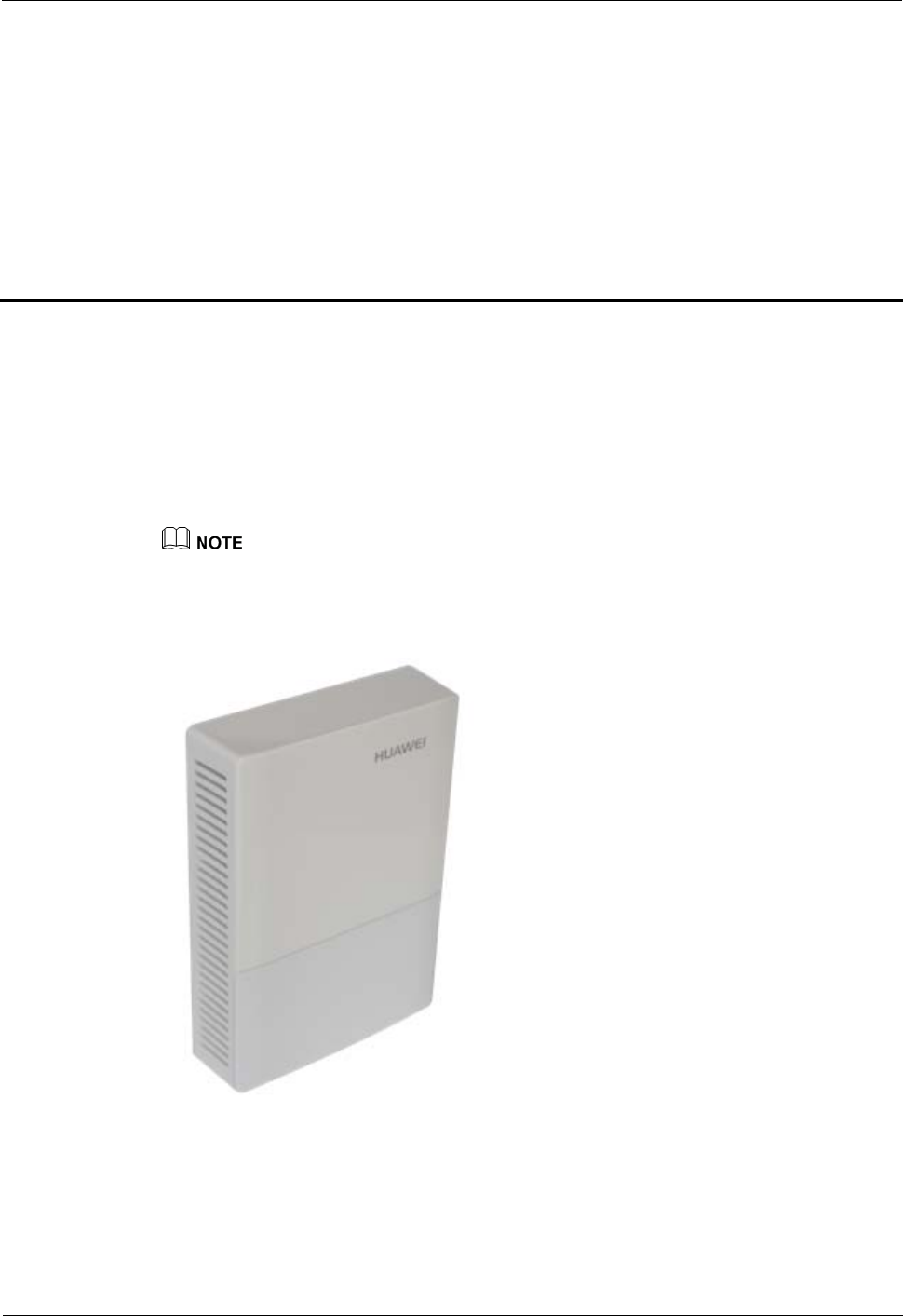
R230D&R240D
Product Description 2 Hardware Structure
Issue 02 (2015-10-31) Huawei Proprietary and Confidential
Copyright © Huawei Technologies Co., Ltd.
4
2 Hardware Structure
2.1 R230D
Appearance
Figure 2-1 shows the appearance of the R230D.
The actual device appearance may be different from the following device appearance; these differences
will not affect device functions.
Figure 2-1 R230D appearance
Port
The following figure shows ports on the R230D.
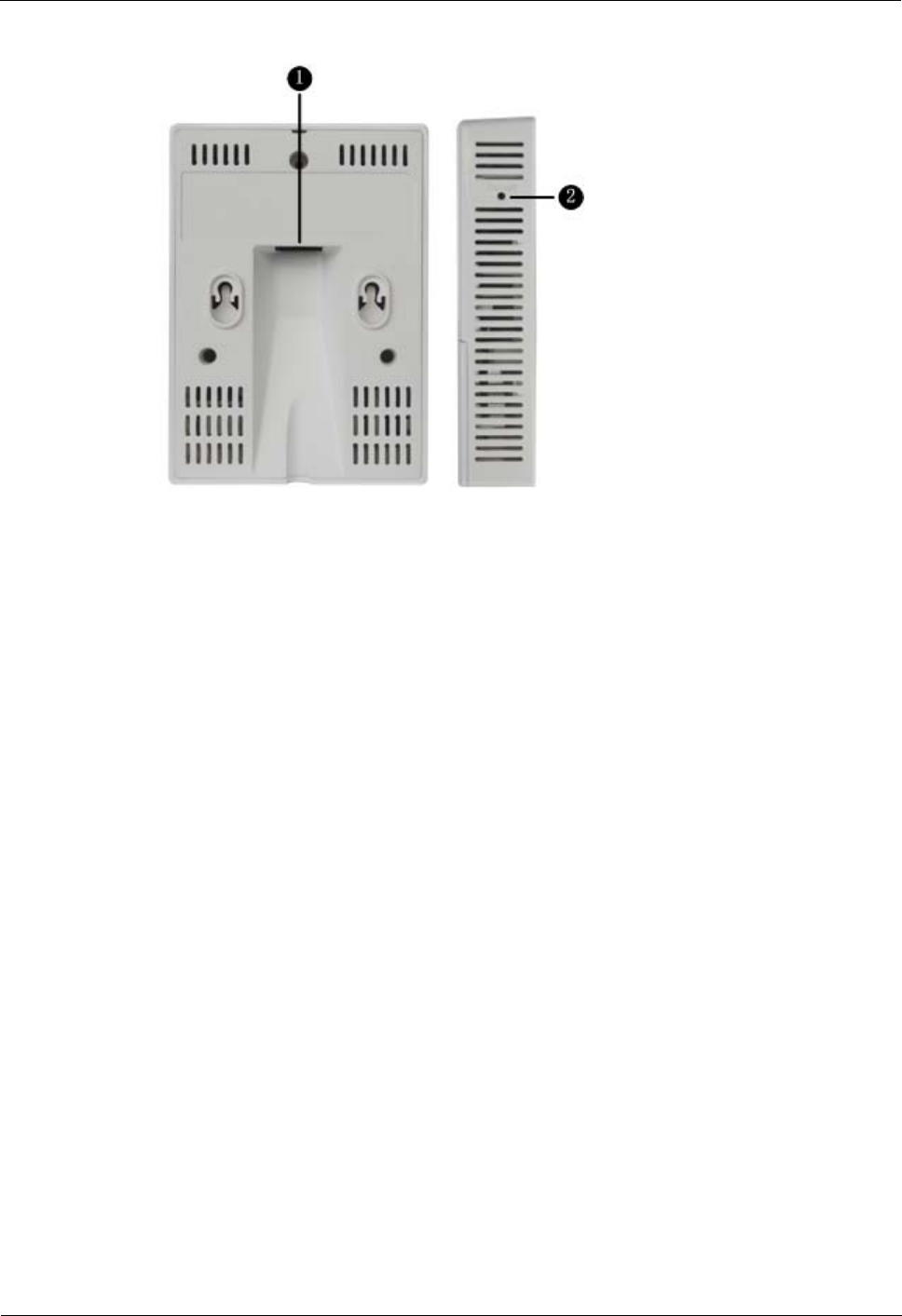
R230D&R240D
Product Description 2 Hardware Structure
Issue 02 (2015-10-31) Huawei Proprietary and Confidential
Copyright © Huawei Technologies Co., Ltd.
5
Figure 2-2 R230D ports
As shown in Figure 2-2, each port can be described as follows:
1. ETH/PoE: 10/100M port used to connect to the wired Ethernet. The port can connect to a
PoE power supply to provide power for the RRU.
2. Default: Reset button used to restore factory settings if you hold down the button more
than 3 seconds.
LED Indicator
The R230D provides only one indicator, as shown in Figure 2-3.
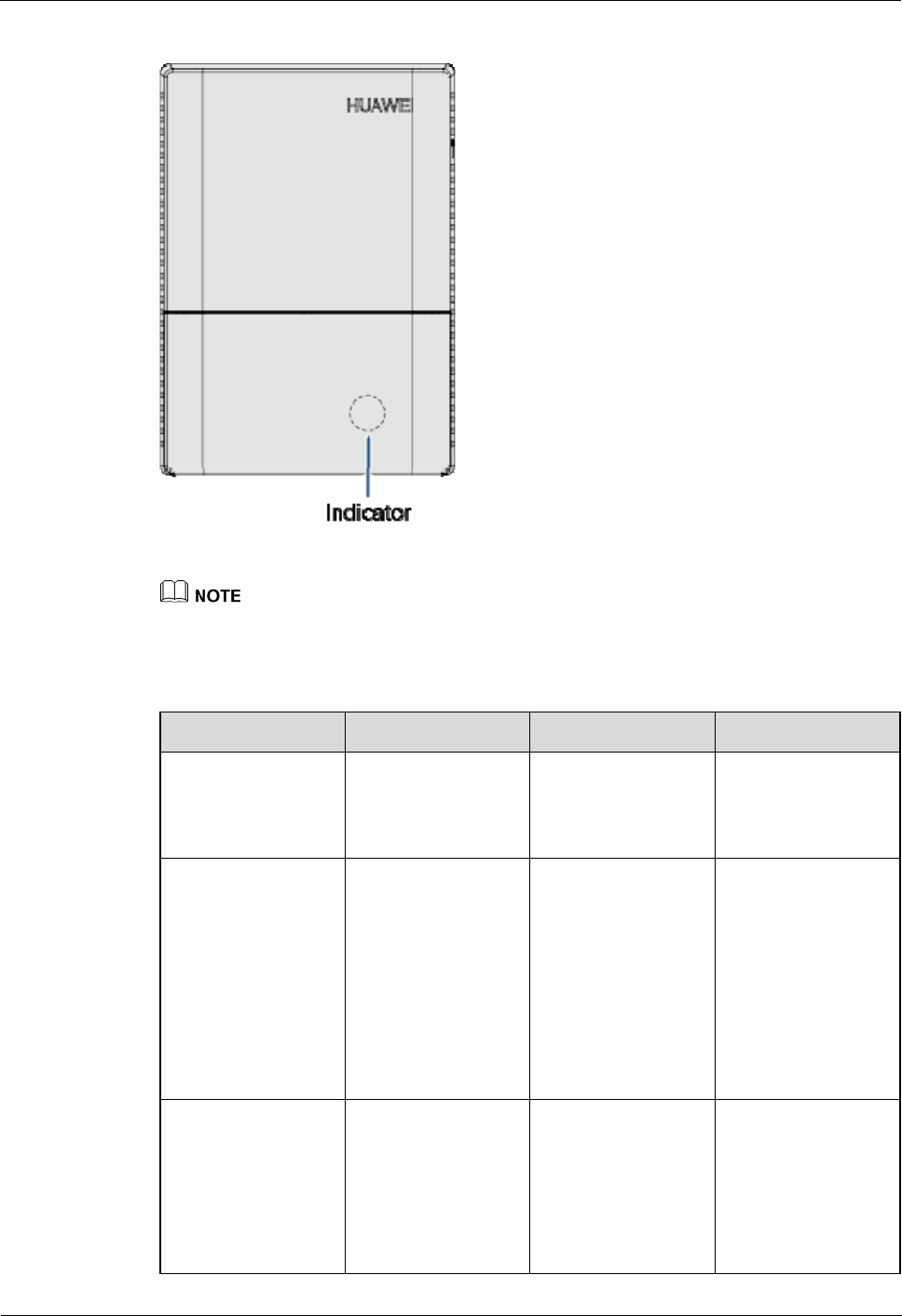
R230D&R240D
Product Description 2 Hardware Structure
Issue 02 (2015-10-31) Huawei Proprietary and Confidential
Copyright © Huawei Technologies Co., Ltd.
6
Figure 2-3 Indicator on the R230D
The indicator is located inside the panel, which turns on after the AP is powered on.
Indicator colors may vary slightly at different temperature.
Table 2-1 Description of the indicator on the R230D
Type Color Status Description
Default status after
power-on
Green Steady on The AP is just
powered on and the
software is not
started yet.
Software startup
status
Green Steady on after
blinking once
After the system is
reset and starts
uploading the
software, the
indicator blinks
green once. Until the
software is uploaded
and started, the
indicator remains
steady green.
Running status Green Blinking once every
2s (0.5 Hz)
The system is
running properly,
the Ethernet
connection is
normal, and STAs
are associated with
the AP.

R230D&R240D
Product Description 2 Hardware Structure
Issue 02 (2015-10-31) Huawei Proprietary and Confidential
Copyright © Huawei Technologies Co., Ltd.
7
Type Color Status Description
Blinking once every
5s (0.2 Hz)
The system is
running properly,
the Ethernet
connection is
normal, and no STA
is associated with
the AP. The system
is in low power
consumption state.
Alarm Green Blinking once
Alarm Green every
0.25s (4 Hz)
The software is
being upgraded.
After the
software is
uploaded and
started, the AP
working in Fit
AP mode
requests to go
online on the AC
and maintains
this state until it
goes online
successfully on
the AC (before
the CAPWAP
link is
established).
The AP
registration fails
(the CAPWAP
link is
disconnected).
Fault Red Steady on A fault that affects
services has
occurred, such as a
DRAM detection
failure or system
software loading
failure. The fault
cannot be
automatically
rectified and must be
rectified manually.
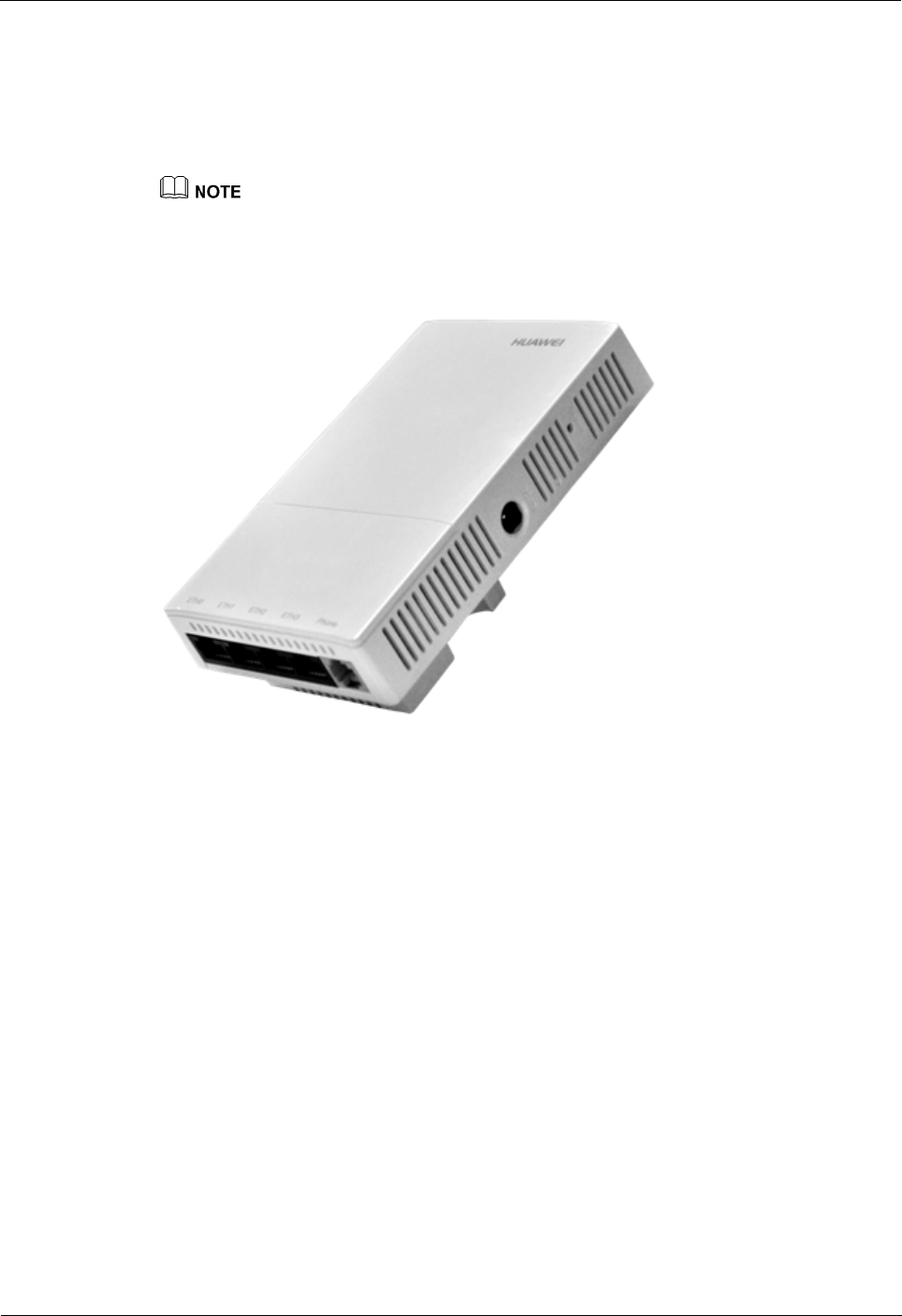
R230D&R240D
Product Description 2 Hardware Structure
Issue 02 (2015-10-31) Huawei Proprietary and Confidential
Copyright © Huawei Technologies Co., Ltd.
8
2.2 R240D
Appearance
Figure 2-4 shows the appearance of the device.
The actual device appearance may be different from the following device appearance; these differences
will not affect device functions.
Figure 2-4 Appearance
Port
Figure 2-5 shows ports on the device.
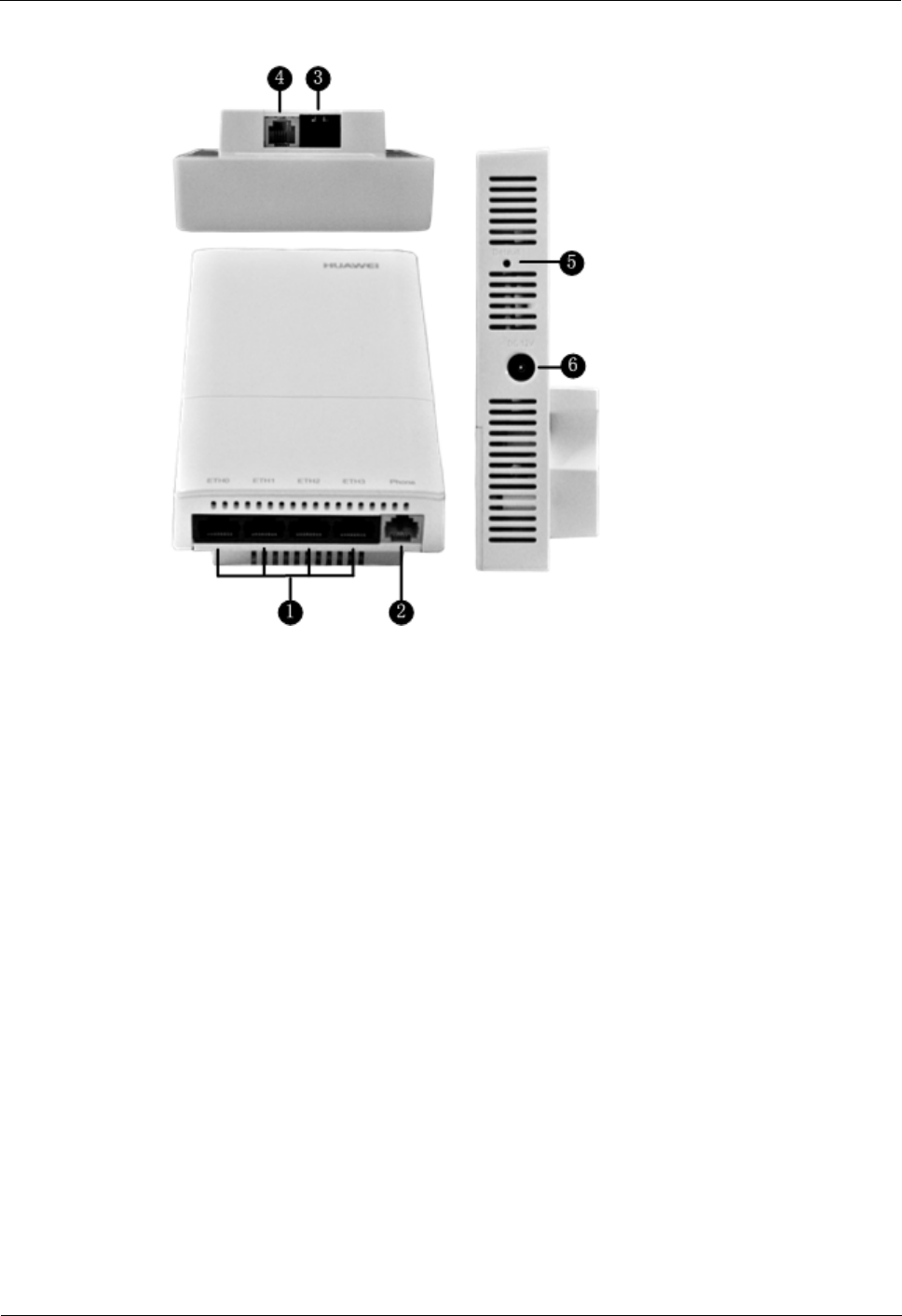
R230D&R240D
Product Description 2 Hardware Structure
Issue 02 (2015-10-31) Huawei Proprietary and Confidential
Copyright © Huawei Technologies Co., Ltd.
9
Figure 2-5 Ports
Each port can be described as follows:
1. ETH0~3: 10/100M port used to connect to the wired Ethernet.
2. Phone: Phone interface: connects to a POTS phone or modem device.
3. GE/PoE: 10/100/1000M port used to connect to the wired Ethernet. The port can connect
to a PoE power supply to provide power for the device.
4. Phone: Phone interface: connects to a traditional PSTN.
5. Default: Reset button used to restore factory settings if you hold down the button more
than 3 seconds.
6. Power input interface: 12 V DC.
LED Indicator
R240D provides only one indicator, as shown in Figure 2-6.
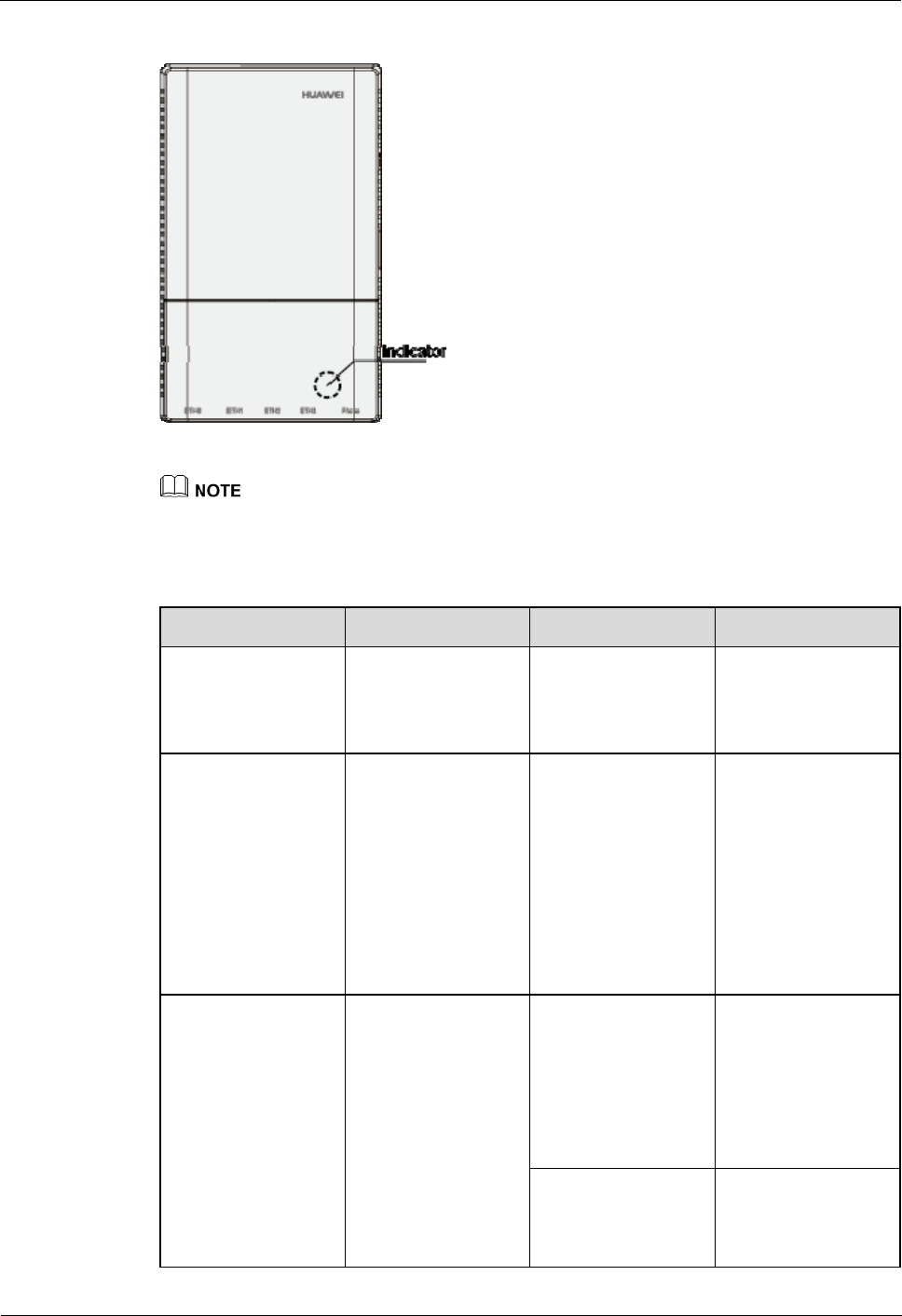
R230D&R240D
Product Description 2 Hardware Structure
Issue 02 (2015-10-31) Huawei Proprietary and Confidential
Copyright © Huawei Technologies Co., Ltd.
10
Figure 2-6 Indicator on the R240D
The indicator is located inside the panel, which turns on after the AP is powered on.
Indicator colors may vary slightly at different temperature.
Table 2-2 Description of the indicator on the R240D
Type Color Status Description
Default status after
power-on
Green Steady on The AP is just
powered on and the
software is not
started yet.
Software startup
status
Green Steady on after
blinking once
After the system is
reset and starts
uploading the
software, the
indicator blinks
green once. Until the
software is uploaded
and started, the
indicator remains
steady green.
Running status Green Blinking once every
2s (0.5 Hz)
The system is
running properly,
the Ethernet
connection is
normal, and STAs
are associated with
the AP.
Blinking once every
5s (0.2 Hz)
The system is
running properly,
the Ethernet
connection is

R230D&R240D
Product Description 2 Hardware Structure
Issue 02 (2015-10-31) Huawei Proprietary and Confidential
Copyright © Huawei Technologies Co., Ltd.
11
Type Color Status Description
normal, and no STA
is associated with
the AP. The system
is in low power
consumption state.
Alarm Green Blinking once
Alarm Green every
0.25s (4 Hz)
The software is
being upgraded.
After the
software is
uploaded and
started, the AP
working in Fit
AP mode
requests to go
online on the AC
and maintains
this state until it
goes online
successfully on
the AC (before
the CAPWAP
link is
established).
The AP
registration fails
(the CAPWAP
link is
disconnected).
Fault Red Steady on A fault that affects
services has
occurred, such as a
DRAM detection
failure or system
software loading
failure. The fault
cannot be
automatically
rectified and must be
rectified manually.

R230D&R240D
Product Description 3 Product Features
Issue 02 (2015-10-31) Huawei Proprietary and Confidential
Copyright © Huawei Technologies Co., Ltd.
12
3 Product Features
3.1 WLAN Features
WLAN features supported by the AP are as follows:
Comply with IEEE 802.11a/b/g/n/ac
The maximum rate of 1.16Gbit/s
Maximum ratio combining (MRC)
Space time block code (STBC)
Beamforming
Low-density parity-check (LDPC)
Maximum-likelihood detection (MLD)
Frame aggregation, including A-MPDU (Tx/Rx) and A-MSDU (Rx only)
802.11 dynamic frequency selection (DFS)
Short GI in 20 MHz, 40 MHz and 80 MHz modes
Priority mapping and packet scheduling based on a Wi-Fi Multimedia (WMM) profile to
implement priority-based data processing and forwarding
Automatic and manual rate adjustment
WLAN channel management and channel rate adjustment
For details about WLAN channel management, see the Country Code & Channel Compliance Table.
Automatic channel scanning and interference avoidance
Service set identifier (SSID) hiding
Signal sustain technology (SST)
Unscheduled automatic power save delivery (U-APSD)
Control and Provisioning of Wireless Access Points (CAPWAP)
Automatic login
Extended Service Set (ESS)
Multi-user CAC

R230D&R240D
Product Description 3 Product Features
Issue 02 (2015-10-31) Huawei Proprietary and Confidential
Copyright © Huawei Technologies Co., Ltd.
13
3.2 Network Features
Network features supported by the AP are as follows:
Compliance with IEEE 802.3u
Auto-negotiation of the rate and duplex mode and automatic switchover between the
Media Dependent Interface (MDI) and Media Dependent Interface Crossover (MDI-X)
Compliance with IEEE 802.1q
SSID-based VLAN assignment
VLAN trunk on uplink Ethernet ports
AP control channel in tagged and untagged mode
DHCP client, obtaining IP addresses through DHCP
Tunnel data forwarding and direct data forwarding
STA isolation in the same VLAN
Access control lists (ACLs)
Link Layer Discovery Protocol (LLDP)
Uninterrupted service forwarding upon CAPWAP channel disconnection
Unified authentication on the AC
AC dual-link backup
IPv6
3.3 QoS Features
QoS features supported by the AP are as follows:
Priority mapping and packet scheduling based on a Wi-Fi Multimedia (WMM) profile to
implement priority-based data processing and forwarding
WMM parameter management for each radio
WMM power saving
Priority mapping for upstream packets and flow-based mapping for downstream packets
Queue mapping and scheduling
User-based bandwidth limiting
Adaptive bandwidth management (the system dynamically adjusts bandwidth based on
the number of users and radio environment to improve user experience)
Airtime scheduling
3.4 Security Features
Security features supported by the AP are as follows:
Open system authentication
WEP authentication/encryption using a 64-bit, 128-bit, or 152-bit encryption key
WPA/WPA2-PSK authentication and encryption (WPA/WPA2 personal edition)
WPA/WPA2-802.1x authentication and encryption (WPA/WPA2 enterprise edition)

R230D&R240D
Product Description 3 Product Features
Issue 02 (2015-10-31) Huawei Proprietary and Confidential
Copyright © Huawei Technologies Co., Ltd.
14
WPA-WPA2 hybrid authentication
WAPI authentication and encryption
Supports wireless intrusion detection system (WIDS) and wireless intrusion prevention
system (WIPS), including rogue device detection and countermeasure, attack detection
and dynamic blacklist, STA/AP blacklist and whitelist.
802.1x authentication, MAC address authentication, and Portal authentication
DHCP Snooping
DAI (Dynamic ARP Inspection)
IPSG (IP Source Guard)
3.5 Maintenance Features
Maintenance features supported by the AP are as follows:
Unified management and maintenance on the AC
Automatic login and configuration loading, and plug-and-play (PnP)
Batch upgrade
Telnet
STelnet using SSH v2
Real-time configuration monitoring and fast fault location using the NMS
System status alarm
3.6 BYOD
BYOD features supported by the AP are as follows:
Identifies the device type according to the organizationally unique identifier (OUI) in the
MAC address.
Identifies the device type according to the user agent (UA) information in an HTTP
packet.
Identifies the device type according to DHCP options.
The RADIUS server delivers packet forwarding, security, and QoS policies according to
the device type carried in the RADIUS authentication and accounting packets.
3.7 Spectrum Analysis
Spectrum analysis features supported by the AP are as follows:
Identifies interference sources such as baby monitors, Bluetooth devices, digital cordless
phones (at 2.4 GHz frequency band only), wireless audio transmitters (at both the 2.4
GHz and 5 GHz frequency bands), wireless game controllers, and microwaves.
Works with eSight to locate and perform spectrum analysis on interference sources.

R230D&R240D
Product Description 4 Technical Specifications
Issue 02 (2015-10-31) Huawei Proprietary and Confidential
Copyright © Huawei Technologies Co., Ltd.
15
4 Technical Specifications
4.1 Basic Specifications
Table 4-1 Basic specifications of the R230D
Item Description
Technical specifications Dimensions (H x W x D) 26 mm x 120 mm x 86 mm
Weight 0.1 kg
System memory 128 MB DDR2
32 MB flash memory
Power parameters Power input PoE power supply in
compliance with IEEE
802.3af
Maximum power
consumption
5.1 W
NOTE
The actual maximum power
consumption depends on local
laws and regulations.
Environment specifications Operating temperature and
altitude
-60 m to 1800 m: 0°C to
40°C
1,800 m to 5,000 m: The
highest operating
temperature reduces by 1°C
every time the altitude
increases by 300 m.
Storage temperature -40°C to +70°C
Operating humidity 5% to 95%
(non-condensing)
IP rating IP20
Atmospheric pressure 70 kPa to 106 kPa
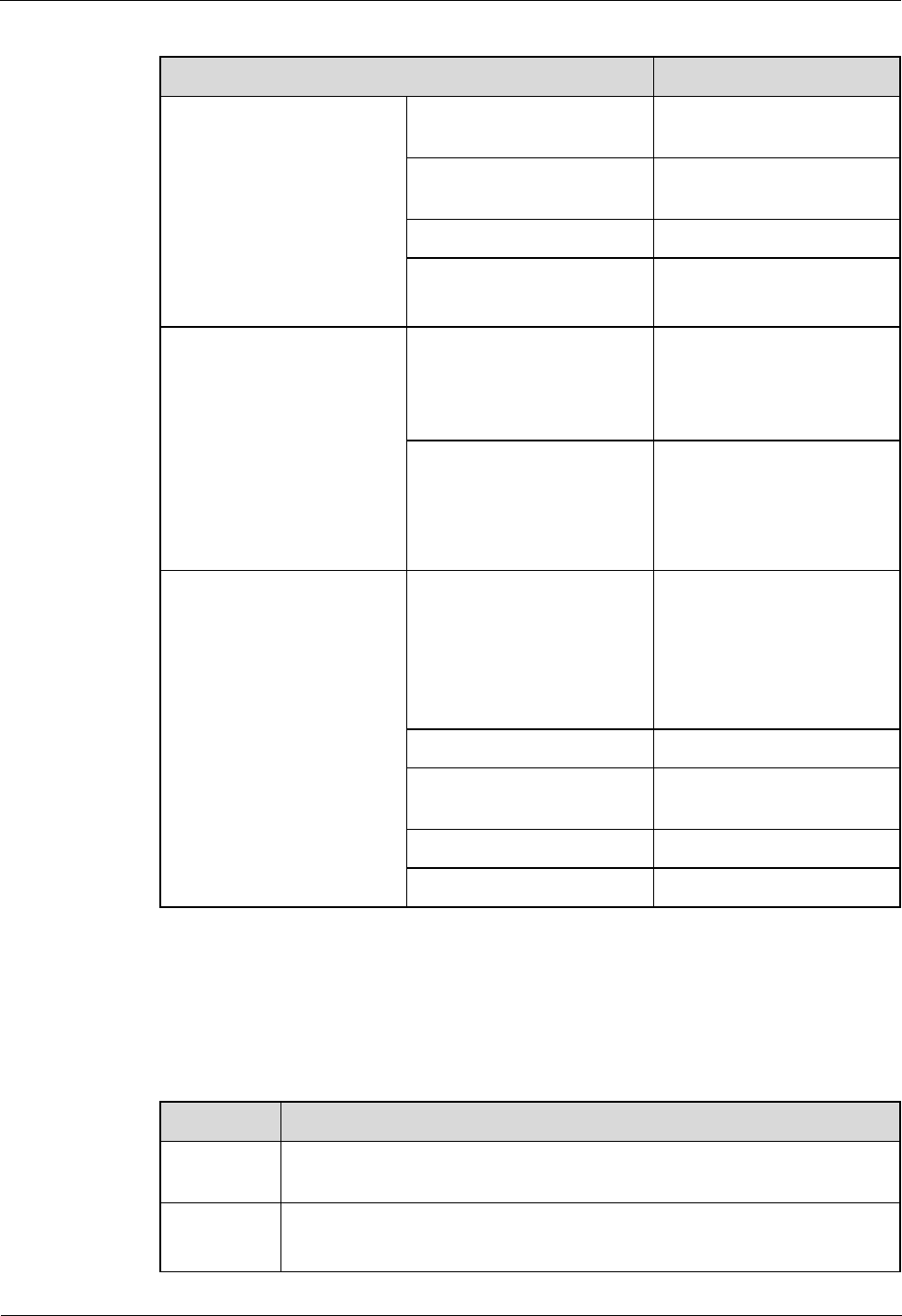
R230D&R240D
Product Description 4 Technical Specifications
Issue 02 (2015-10-31) Huawei Proprietary and Confidential
Copyright © Huawei Technologies Co., Ltd.
16
Table 4-2 Basic specifications of the R240D
Item Description
Technical specifications Dimensions outside the wall
(L × W × H)
140mm×86mm×25mm
Dimensions inside the wall
(L × W × H)
51.5mm×63.5mm×16.5mm
Weight 0.2 kg
System memory 128 MB DDR2
32 MB Flash
Power specifications Power input 12 V±10%
PoE power: in
compliance with IEEE
802.3af/at
Maximum power
consumption
8.7 W
NOTE
The actual maximum power
consumption depends on local
laws and regulations.
Environment specifications Operating temperature and
altitude
-60 m to +1800 m: 0°C to
+40°C
1800 m to 5000 m:
Temperature decreases by
1°C every time the altitude
increases 300 m.
Storage temperature -40°C to +70°C
Operating humidity 5% to 95%
(non-condensing)
IP rating IP20
Atmospheric pressure 70 kPa to 106 kPa
4.2 Radio Specifications (R230D)
Table 4-3 Radio specifications
Item Description
Antenna
type
Built-in antenna
Antenna
gain
2.4 GHz: 3 dBi
5 GHz: 4 dBi

R230D&R240D
Product Description 4 Technical Specifications
Issue 02 (2015-10-31) Huawei Proprietary and Confidential
Copyright © Huawei Technologies Co., Ltd.
17
Item Description
Maximum
number of
concurrent
users
≤256
Maximum
number of
VAPs for
each radio
8
Maximum
transmit
power
2.4 GHz: 20 dBm (combined power)
5 GHz: 18 dBm (combined power)
NOTE
The actual transmit power depends on local laws and regulations.
You can adjust the transmit power from the maximum transmit power to 1 dBm, with
a step of 1 dB.
Maximum
number of
non-overlap
ping
channels
2.4 GHz
802.11b/g
20 MHz: 3
802.11n
20 MHz: 3
40 MHz: 1
5 GHz
802.11a
− 20 MHz:
13
802.11n
− 20 MHz:
13
− 40 MHz:
6
802.11ac
− 20 MHz:
13
− 40 MHz:
6
− 80 MHz:
3
NOTE
The table uses the number of
non-overlapping channels supported by
China as an example. The number of
non-overlapping channels varies in
different countries. For details, see the
Country Codes & Channels Compliance
Channel rate 802.11b: 1, 2, 5.5, and 11 Mbit/s
802.11a/g: 6, 9, 12, 18, 24, 36, 48, and 54 Mbit/s
802.11n: 6.5 to 300 Mbit/s
802.11ac: 6.5 to 867 Mbit/s
Receiver
sensitivity
(Typical
values)
2.4 GHz
802.11b (CCK)
-102 dBm @
1 Mb/s
-97 dBm @ 2
Mb/s
-94 dBm @
5.5 Mb/s
-91 dBm @
2.4 GHz
802.11g
(non-HT20)
-94 dBm @ 6
Mb/s
-94 dBm @ 9
Mb/s
-94 dBm @
12 Mb/s
2.4 GHz
802.11n (HT20)
-94 dBm @
MCS0
-94 dBm @
MCS1
-92 dBm @
MCS2
-88 dBm @
2.4 GHz
802.11n(HT40)
-91 dBm @
MCS0
-91 dBm @
MCS1
-89 dBm @
MCS2
-85 dBm @

R230D&R240D
Product Description 4 Technical Specifications
Issue 02 (2015-10-31) Huawei Proprietary and Confidential
Copyright © Huawei Technologies Co., Ltd.
18
Item Description
11 Mb/s -92 dBm @
18 Mb/s
-89 dBm @
24 Mb/s
-86 dBm @
36 Mb/s
-82 dBm @
48 Mb/s
-81 dBm @
54 Mb/s
MCS3
-85 dBm @
MCS4
-81 dBm @
MCS5
-79 dBm @
MCS6
-77 dBm @
MCS7
-92 dBm @
MCS8
-92 dBm @
MCS9
-90 dBm @
MCS10
-86 dBm @
MCS11
-83 dBm @
MCS12
-79 dBm @
MCS13
-77 dBm @
MCS14
-75 dBm @
MCS15
MCS3
-82 dBm @
MCS4
-78 dBm @
MCS5
-76 dBm @
MCS6
-75 dBm @
MCS7
-89 dBm @
MCS8
-89 dBm @
MCS9
-87 dBm @
MCS10
-83 dBm @
MCS11
-80 dBm @
MCS12
-76 dBm @
MCS13
-74 dBm @
MCS14
-73 dBm @
MCS15
5 GHz
802.11a
(non-HT20)
-96 dBm @ 6
Mb/s
-95 dBm @ 9
Mb/s
-94 dBm @
12 Mb/s
-92 dBm @
18 Mb/s
-88 dBm @
24 Mb/s
-85 dBm @
36 Mb/s
-80 dBm @
48 Mb/s
-79 dBm @
54 Mb/s
5 GHz
802.11n (HT20)
-96 dBm @
MCS0
-94 dBm @
MCS1
-92 dBm @
MCS2
-87 dBm @
MCS3
-84 dBm @
MCS4
-79 dBm @
MCS5
-78 dBm @
MCS6
-76 dBm @
MCS7
-94 dBm @
MCS8
5 GHz
802.11n (HT40)
-93 dBm @
MCS0
-91 dBm @
MCS1
-89 dBm @
MCS2
-84 dBm @
MCS3
-81 dBm @
MCS4
-77 dBm @
MCS5
-76 dBm @
MCS6
-74 dBm @
MCS7
-91 dBm @
MCS8
-

R230D&R240D
Product Description 4 Technical Specifications
Issue 02 (2015-10-31) Huawei Proprietary and Confidential
Copyright © Huawei Technologies Co., Ltd.
19
Item Description
-92 dBm @
MCS9
-90 dBm @
MCS10
-85 dBm @
MCS11
-82 dBm @
MCS12
-77 dBm @
MCS13
-76 dBm @
MCS14
-74 dBm @
MCS15
-89 dBm @
MCS9
-87 dBm @
MCS10
-82 dBm @
MCS11
-79 dBm @
MCS12
-75 dBm @
MCS13
-74 dBm @
MCS14
-72 dBm @
MCS15
5 GHz
802.11ac
(VTH20)
-96 dBm @
MCS0NSS1
-94 dBm @
MCS1NSS1
-92 dBm @
MCS2NSS1
-87 dBm @
MCS3NSS1
-84 dBm @
MCS4NSS1
-79 dBm @
MCS5NSS1
-78 dBm @
MCS6NSS1
-76 dBm @
MCS7NSS1
-72 dBm @
MCS8NSS1
-94 dBm @
MCS0NSS2
-92 dBm @
MCS1NSS2
-90 dBm @
MCS2NSS2
-85 dBm @
MCS3NSS2
-82 dBm @
MCS4NSS2
5 GHz
802.11ac
(VTH40)
-93 dBm @
MCS0NSS1
-91 dBm @
MCS1NSS1
-89 dBm @
MCS2NSS1
-84 dBm @
MCS3NSS1
-81 dBm @
MCS4NSS1
-77 dBm @
MCS5NSS1
-75 dBm @
MCS6NSS1
-74 dBm @
MCS7NSS1
-69 dBm @
MCS8NSS1
-67 dBm @
MCS9NSS1
-91 dBm @
MCS0NSS2
-89 dBm @
MCS1NSS2
-87 dBm @
MCS2NSS2
-82 dBm @
MCS3NSS2
5 GHz
802.11ac
(VTH80)
-90 dBm @
MCS0NSS1
-88 dBm @
MCS1NSS1
-85 dBm @
MCS2NSS1
-81 dBm @
MCS3NSS1
-78 dBm @
MCS4NSS1
-74 dBm @
MCS5NSS1
-72 dBm @
MCS6NSS1
-70 dBm @
MCS7NSS1
-66 dBm @
MCS8NSS1
-63 dBm @
MCS9NSS1
-88 dBm @
MCS0NSS2
-86 dBm @
MCS1NSS2
-83 dBm @
MCS2NSS2
-79 dBm @
MCS3NSS2
-
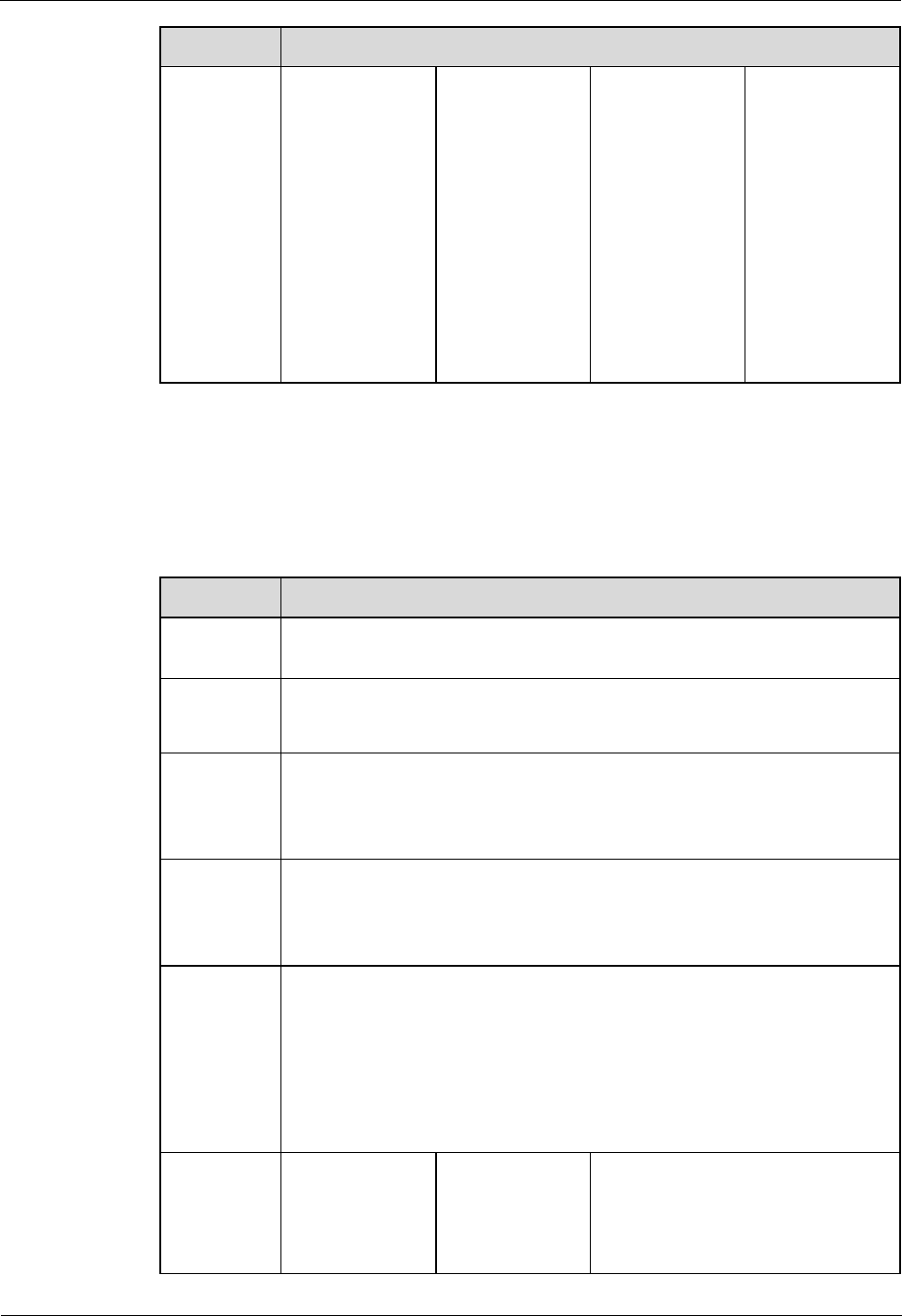
R230D&R240D
Product Description 4 Technical Specifications
Issue 02 (2015-10-31) Huawei Proprietary and Confidential
Copyright © Huawei Technologies Co., Ltd.
20
Item Description
-77 dBm @
MCS5NSS2
-76 dBm @
MCS6NSS2
-74 dBm @
MCS7NSS2
-70 dBm @
MCS8NSS2
-79 dBm @
MCS4NSS2
-75 dBm @
MCS5NSS2
-73 dBm @
MCS6NSS2
-72 dBm @
MCS7NSS2
-67 dBm @
MCS8NSS2
-65 dBm @
MCS9NSS2
-76 dBm @
MCS4NSS2
-72 dBm @
MCS5NSS2
-70 dBm @
MCS6NSS2
-68 dBm @
MCS7NSS2
-64 dBm @
MCS8NSS2
-61 dBm @
MCS9NSS2
4.3 Radio Specifications (R240D)
Table 4-4 Radio specifications
Item Description
Antenna
type
Built-in antenna
Antenna
gain
2.4 GHz: 2 dBi(peak 3.7dBi)
5 GHz: 3 dBi(peak 5.5dBi)
Maximum
number of
concurrent
users
≤256
Maximum
number of
VAPs for
each radio
8
Maximum
transmit
power
2.4 GHz: 21 dBm (combined power)
5 GHz: 20 dBm (combined power)
NOTE
The actual transmit power depends on local laws and regulations. The R240D uses a
86-type box and applies only to countries and regions that support 86-type boxes.
You can adjust the transmit power from the maximum transmit power to 1 dBm, with
a step of 1 dB.
Maximum
number of
non-overlap
ping
2.4 GHz
802.11b/g
20 MHz: 3
5 GHz
802.11a
− 20 MHz:
13
NOTE
The table uses the number of
non-overlapping channels supported by
China as an example. The number of
non-overlapping channels varies in

R230D&R240D
Product Description 4 Technical Specifications
Issue 02 (2015-10-31) Huawei Proprietary and Confidential
Copyright © Huawei Technologies Co., Ltd.
21
Item Description
channels 802.11n
20 MHz: 3
40 MHz: 1
802.11n
− 20 MHz:
13
− 40 MHz:
6
802.11ac
− 20 MHz:
13
− 40 MHz:
6
− 80 MHz:
3
different countries. For details, see the
Country Codes & Channels Compliance
Channel rate 802.11b: 1, 2, 5.5, and 11 Mbit/s
802.11a/g: 6, 9, 12, 18, 24, 36, 48, and 54 Mbit/s
802.11n: 6.5 to 300 Mbit/s
802.11ac: 6.5 to 867 Mbit/s
Receiver
sensitivity
(Typical
values)
2.4 GHz
802.11b (CCK)
-101 dBm @
1 Mbit/s
-96 dBm @ 2
Mbit/s
-94 dBm @
5.5 Mbit/s
-90 dBm @
11 Mbit/s
2.4 GHz
802.11g
(non-HT20)
-95 dBm @ 6
Mbit/s
-95 dBm @ 9
Mbit/s
-94 dBm @
12 Mbit/s
-92 dBm @
18 Mbit/s
-88 dBm @
24 Mbit/s
-85 dBm @
36 Mbit/s
-81 dBm @
48 Mbit/s
-79 dBm @
54 Mbit/s
2.4 GHz
802.11n (HT20)
-95 dBm @
MCS0
-94 dBm @
MCS1
-92 dBm @
MCS2
-87 dBm @
MCS3
-84 dBm @
MCS4
-79 dBm @
MCS5
-78 dBm @
MCS6
-77 dBm @
MCS7
-93 dBm @
MCS8
-92 dBm @
MCS9
-90 dBm @
MCS10
-85 dBm @
MCS11
-82 dBm @
MCS12
2.4 GHz
802.11n(HT40)
-93 dBm @
MCS0
-91 dBm @
MCS1
-89 dBm @
MCS2
-84 dBm @
MCS3
-81 dBm @
MCS4
-77 dBm @
MCS5
-75 dBm @
MCS6
-74 dBm @
MCS7
-91 dBm @
MCS8
-89 dBm @
MCS9
-87 dBm @
MCS10
-82 dBm @
MCS11
-79 dBm @
MCS12

R230D&R240D
Product Description 4 Technical Specifications
Issue 02 (2015-10-31) Huawei Proprietary and Confidential
Copyright © Huawei Technologies Co., Ltd.
22
Item Description
-77 dBm @
MCS13
-76 dBm @
MCS14
-75 dBm @
MCS15
-75 dBm @
MCS13
-73 dBm @
MCS14
-72 dBm @
MCS15
5 GHz
802.11a
(non-HT20)
-94 dBm @ 6
Mbit/s
-94 dBm @ 9
Mbit/s
-93 dBm @
12 Mbit/s
-91 dBm @
18 Mbit/s
-87 dBm @
24 Mbit/s
-84 dBm @
36 Mbit/s
-79 dBm @
48 Mbit/s
-78 dBm @
54 Mbit/s
5 GHz
802.11n (HT20)
-94 dBm @
MCS0
-93 dBm @
MCS1
-90 dBm @
MCS2
-86 dBm @
MCS3
-83 dBm @
MCS4
-78 dBm @
MCS5
-77 dBm @
MCS6
-76 dBm @
MCS7
-92 dBm @
MCS8
-91 dBm @
MCS9
-88 dBm @
MCS10
-84 dBm @
MCS11
-81 dBm @
MCS12
-76 dBm @
MCS13
-75 dBm @
MCS14
-74 dBm @
MCS15
5 GHz
802.11n (HT40)
-91 dBm @
MCS0
-90 dBm @
MCS1
-87 dBm @
MCS2
-83 dBm @
MCS3
-80 dBm @
MCS4
-76 dBm @
MCS5
-74 dBm @
MCS6
-73 dBm @
MCS7
-89 dBm @
MCS8
-88 dBm @
MCS9
-85 dBm @
MCS10
-81 dBm @
MCS11
-78 dBm @
MCS12
-74 dBm @
MCS13
-72 dBm @
MCS14
-71 dBm @
MCS15
-
5 GHz
802.11ac
(VTH20)
-95 dBm @
MCS0NSS1
5 GHz
802.11ac
(VTH40)
-91 dBm @
MCS0NSS1
5 GHz
802.11ac
(VTH80)
-88 dBm @
MCS0NSS1
-

R230D&R240D
Product Description 4 Technical Specifications
Issue 02 (2015-10-31) Huawei Proprietary and Confidential
Copyright © Huawei Technologies Co., Ltd.
23
Item Description
-93 dBm @
MCS1NSS1
-90 dBm @
MCS2NSS1
-86 dBm @
MCS3NSS1
-83 dBm @
MCS4NSS1
-78 dBm @
MCS5NSS1
-77 dBm @
MCS6NSS1
-75 dBm @
MCS7NSS1
-71 dBm @
MCS8NSS1
-93 dBm @
MCS0NSS2
-91 dBm @
MCS1NSS2
-88 dBm @
MCS2NSS2
-84 dBm @
MCS3NSS2
-81 dBm @
MCS4NSS2
-76 dBm @
MCS5NSS2
-75 dBm @
MCS6NSS2
-73 dBm @
MCS7NSS2
-69 dBm @
MCS8NSS2
-90 dBm @
MCS1NSS1
-88 dBm @
MCS2NSS1
-83 dBm @
MCS3NSS1
-80 dBm @
MCS4NSS1
-76 dBm @
MCS5NSS1
-74 dBm @
MCS6NSS1
-72 dBm @
MCS7NSS1
-68 dBm @
MCS8NSS1
-66 dBm @
MCS9NSS1
-89 dBm @
MCS0NSS2
-88 dBm @
MCS1NSS2
-86 dBm @
MCS2NSS2
-81 dBm @
MCS3NSS2
-78 dBm @
MCS4NSS2
-74 dBm @
MCS5NSS2
-72 dBm @
MCS6NSS2
-70 dBm @
MCS7NSS2
-65 dBm @
MCS8NSS2
-63 dBm @
MCS9NSS2
-87 dBm @
MCS1NSS1
-84 dBm @
MCS2NSS1
-80 dBm @
MCS3NSS1
-77 dBm @
MCS4NSS1
-73 dBm @
MCS5NSS1
-71 dBm @
MCS6NSS1
-69 dBm @
MCS7NSS1
-65 dBm @
MCS8NSS1
-63 dBm @
MCS9NSS1
-86 dBm @
MCS0NSS2
-85 dBm @
MCS1NSS2
-82 dBm @
MCS2NSS2
-78 dBm @
MCS3NSS2
-75 dBm @
MCS4NSS2
-71 dBm @
MCS5NSS2
-69 dBm @
MCS6NSS2
-67 dBm @
MCS7NSS2
-62 dBm @
MCS8NSS2
-60 dBm @
MCS9NSS2

R230D&R240D
Product Description 4 Technical Specifications
Issue 02 (2015-10-31) Huawei Proprietary and Confidential
Copyright © Huawei Technologies Co., Ltd.
24
4.4 Standards Compliance
Safety standards
UL 60950–1
IEC 60950–1
EN 60950–1
GB 4943
Radio standards
ETSI EN 300 328
ETSI EN 301 893
RSS-210
AS/NZS 4268
EMC standards
EN 301 489–1
EN 301 489–17
ETSI EN 60601-1-2
ICES-003
YD/T 1312.2-2004
ITU k.21
GB 9254
GB 17625.1
EN 55022
EN 55024
CISPR 22
CISPR 24
IEC61000-4-6
IEC61000-4-2
IEEE standards
IEEE 802.11a/b/g
IEEE 802.11n
IEEE 802.11ac
IEEE 802.11h
IEEE 802.11d
IEEE 802.11e
Security standards
802.11i, Wi-Fi Protected Access 2 (WPA2), and WPA
802.1X

R230D&R240D
Product Description 4 Technical Specifications
Issue 02 (2015-10-31) Huawei Proprietary and Confidential
Copyright © Huawei Technologies Co., Ltd.
25
Advanced Encryption Standards (AES) and Temporal Key Integrity Protocol (TKIP)
EAP Type (s)
Environment standards
ETSI 300 019-2-1
ETSI 300 019-2-2
ETSI 300 019-2-3
ETSI 300 019-1-1
ETSI 300 019-1-2
ETSI 300 019-1-3
EMF
CENELEC EN 62311
CENELEC EN 50385
RSS-102
RoHS
Directive 2002/95/EC & 2011/65/EU
Reach
Regulation 1907/2006/EC
WEEE
Directive 2002/96/EC & 2012/19/EU
FCC Statement
This equipment has been tested and found to comply with the limits for a Class B digital
device, pursuant to part 15 of the FCC Rules. These limits are designed to provide
reasonable protection against harmful interference in a residential installation. This
equipment generates, uses and can radiate radio frequency energy and, if not installed
and used in accordance with the instructions, may cause harmful interference to radio
communications. However, there is no guarantee that interference will not occur in a
particular installation. If this equipment does cause harmful interference to radio or
television reception, which can be determined by turning the equipment off and on, the
user is encouraged to try to correct the interference by one or more of the following
measures:
—Reorient or relocate the receiving antenna.
—Increase the separation between the equipment and receiver.
—Connect the equipment into an outlet on a circuit different from that to which the
receiver is connected.
—Consult the dealer or an experienced radio/TV technician for help.
FCC Radiation Exposure Statement
This device complies with FCC radiation exposure limits set forth for an uncontrolled
environment and it also complies with Part 15 of the FCC RF Rules. This equipment
must be installed and operated in accordance with provided instructions and the

R230D&R240D
Product Description 4 Technical Specifications
Issue 02 (2015-10-31) Huawei Proprietary and Confidential
Copyright © Huawei Technologies Co., Ltd.
26
antenna(s) used for this transmitter must be installed to provide a separation distance of
at least 20 cm from all persons and must not be co-located or operating in conjunction
with any other antenna or transmitter. End-users and installers must be provide with
antenna installation instructions and consider removing the no-collocation statement.
This device complies with Part 15 of the FCC Rules. Operation is subject to the
following two conditions: (1) this device may not cause harmful interference, and (2)
this device must accept any interference received, including interference that may cause
undesired operation.
Caution!
Any changes or modifications not expressly approved by the party responsible for
compliance could void the user's authority to operate the equipment.